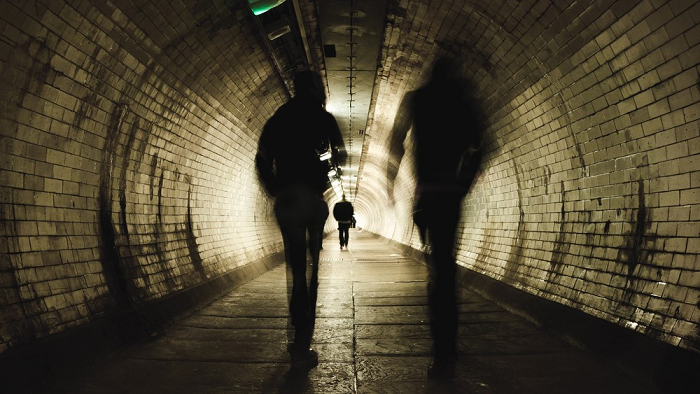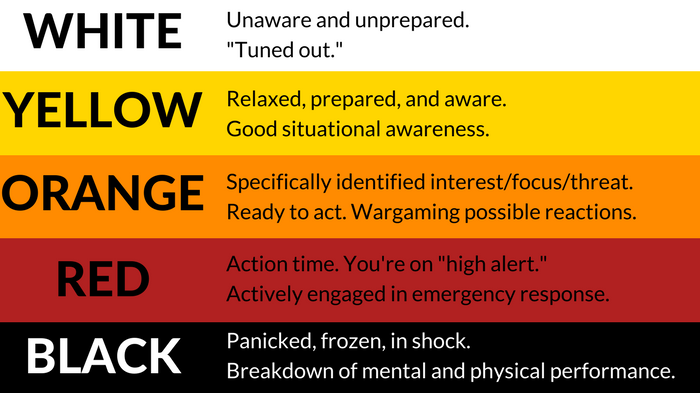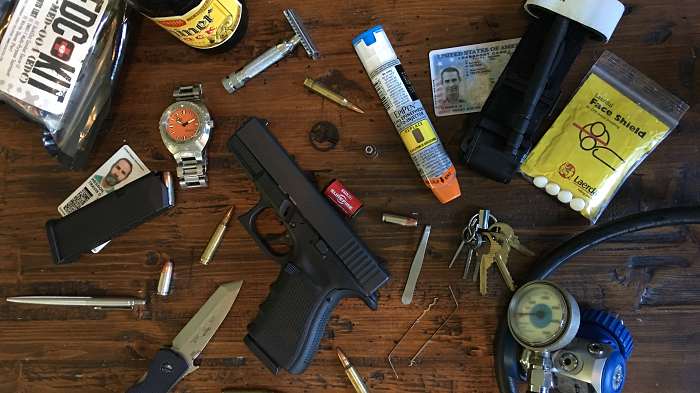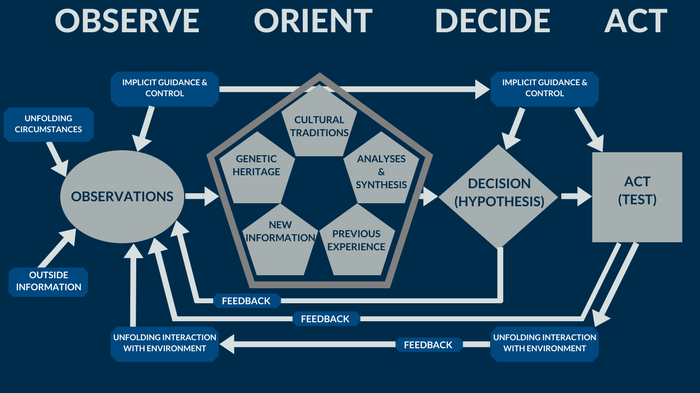Phase 3 — Cultivating the Gentleman Spy Attitude
Lesson 2 — Situational Awareness
LESSON 2: Situational Awareness

“I can tell you the license plate numbers of all six cars outside. I can tell you that our waitress is left-handed and the guy sitting up at the counter weighs two hundred fifteen pounds and knows how to handle himself. I know the best place to look for a gun is the cab or the gray truck outside, and at this altitude, I can run flat out for a half mile before my hands start shaking." ~Jason Bourne, The Bourne Identity
The gentleman spy is the confident warrior, but that is built upon his skill of always knowing what’s going on around him.
When 007 arrives at the Ocean Club in the Bahamas in Casino Royale, he can be seen tying his shoes while checking out the lay of the land and noting where the security cameras are.
Bourne tells us "I come in here, and the first thing I'm doing is I'm catching the sightlines and looking for an exit. I can tell you the license plate numbers of all six cars outside. I can tell you that our waitress is left-handed and the guy sitting up at the counter weighs two hundred fifteen pounds and knows how to handle himself. I know the best place to look for a gun is the cab or the gray truck outside, and at this altitude, I can run flat out for a half mile before my hands start shaking."
Like Bond and Bourne, you need to always know where you are, and who and what is going on around you.
This is called situational awareness (SA), and it is as much of a mindset as a distinct skill.
To hone your SA, you must first recognize and internalize that threats do exist, and you can usually recognize a situation early enough to stay out of it or get the upper hand to guarantee a favorable outcome.
As you start becoming aware, your awareness will build upon itself and continue to get better.
Cooper's Colors

A good way to brief situational awareness is through the use of Cooper’s Colors, which are taught within intelligence, military, and law enforcement communities. These colors refer to five distinct stages of awareness and readiness within which everybody lives.
White — You’re just coasting through whatever you’re doing. Unaware and “tuned out.” You’re in condition white whenever you’re daydreaming, distracted by a phone call or text message, relaxing at home, or asleep.
Many people spend almost their entire lives in condition white, almost completely unaware of the various things that are always happening all around them. In this stage, anything threatening or that happens suddenly can often overwhelm your senses sending your system straight into Black, where your body is overloaded and you are unable to function.
While everybody slips up every once in a while, you should make a conscious effort not to go through your life in condition white.
Yellow — You’re relaxed, but aware of what’s going on around you.
If you’re driving, you’re aware of what is happening in front of and behind you, and you’re able to put yourself in a position where an extreme reaction isn’t necessary.
When you go into a new place you scan the room, looking for threats, exits, and the general lay of the land.
When you’re walking down the street you’re keeping a watchful eye out for people behind you, people approaching your personal space, and anything that looks or “feels” out of place.
Sitting down at a restaurant you choose the seat that gives you the best view of the room, the entrances and exits, so you won’t be caught unaware of anything happening behind you.
Being in condition yellow isn’t paranoia, it’s a general state of attentiveness that will alert you to anything else going on.
Orange — In condition orange, you have identified anything of interest that may prove to be a threat.
A driver ahead of you swerving through traffic that might necessitate a sudden stop or evasive maneuver.
A guy who looks out of place on the street corner, or somebody else walking down the street that is more aware than normal or looks “shady.”
Once something has piqued your interest, you will stay focused on this until you determine that it is, or is not, a threat, before escalating up to condition red, or back down to yellow.
If you’re attacked in this condition, it shouldn’t come as a surprise, as you should have already identified a threat and focused on it.
Once you've moved up to orange or higher, it’s helpful to constantly be running through “what-if’s” so that if action is required, you already have a plan.
Red — You’ve now changed your focus from a potential threat, to a potential target. Whatever you identified in orange has made a threatening move, or events have taken place that will likely necessitate direct action on your part.
This could be the car swerving in front of you causing you to slam on your brakes, or quickly move over to avoid an accident, or it could be the shady character on the street corner approaching you.
At this stage, you’re on “high alert,” and the adrenaline is flowing. You can’t be surprised by an attack and are moving (or have already moved) to a position that will give you the advantage.
Even though you’re amped up on adrenaline, you can still focus and act at this stage. You might lose some fine motor control, and peripheral vision, but you are in control, and controlling the situation to the best of your ability.
This is where previous training comes into play, as you don’t “rise to the occasion” but rather “fall to the level of your training.” The war-gaming you did in yellow and orange might come into play here, and you’re already ahead of the game because you were prepared for the situation you saw coming.
Black — This is not one of Cooper’s original colors but has been added by many to describe the worst possible state. You’re in shock, finished, comatose. Your brain ceases to process information, and you freeze, unable to act.
If you’ve been paying attention, and following the natural progression, you shouldn’t find yourself in this condition at all, but it happens all too often in untrained or unaware individuals. This is often manifest as denial — “this can’t be happening to me” — or the sense of being frozen, unable to act as an event unfolds. When crime victims relay to the media “I never saw it coming,” it’s because they were walking around unaware in condition white and events pushed them straight into condition black.
When this happens, these people are often useless or worse, they are either panicky or are actively being a liability. They are unable to act appropriately for the situation and their immobility or panic will create problems for anybody attempting to deal with the situation. After the fact are unable to recall the order of events, what a perpetrator looked like or the order of events, or even understand what happened at all. Do not be this person.
By living your life in condition yellow — which is by no means difficult once you’ve made the decision to do so — you will be aware and prepared to escalate as things progress.
Baseline

Every environment you find yourself in has its own baseline — the homeostatic state of what everything looks, feels, and sounds like when everything is normal.
Every city, and even different neighborhoods within the same city, have their own baseline. The way people move, how fast or slow they are, how close they stand, how loud they talk, how they gesture, how they dress, even the other sights, sounds, and smells, all contribute to this baseline.
You must start by monitoring this baseline everywhere you go. Different restaurants, events, etc. will all have their own baseline that you'll want to be able to start to recognize and get familiar with right off the bat. The reason you need to understand the baseline is to be able to detect changes in it.
The same way that, if walking in the woods, the animals react to the threat of a predator, so does the city. In the woods, prey animals might make a lot of noise to alert each other to the presence of a predator. Likewise, they might suddenly get very quiet. In the cities, you'll notice the same thing. People will interact differently when there is something going on, or about to go on.
If you're in an area where people are usually talkative and jovial, but are suddenly quiet and wary, it's time to take note of whatever they have noticed. Likewise, if the area is normally more reserved, but today everybody appears on edge. Is the homeless guy, the kid in the hoodie, or the person woman who crossed the street and is walking behind you part of the baseline? Or are they a threat that you need to take note of?
Kim's Game

Keep In Mind (KIM) games are a great tool to use to increase your situational awareness. Taken from the 1901 Kipling novel "Kim," these games are used to enhance your observation skills and memory.
In its most basic iteration, the game is played by having somebody put a bunch of random objects in a box, pile, wherever. You will have a set amount of time to observe the objects before they are covered, then you must describe them as well as possible from memory. To increase the difficulty, add more objects, decrease the amount of time you have to view them, or both.
Don't have a bunch of random stuff or someone to run the game for you? Try to recall the last 5 or 10 make, model, and colors of cars that passed you (or that you passed). Need more challenge? What were their license plate numbers?
To step up the game, randomly play when you're out and about. Close your eyes. How many people are in the room with you? Men? Women? What are they wearing? Who is armed? Where is the nearest exit? Fire extinguisher? AED?
You'll be amazed at how little of the world you notice when you first start playing. But just like staying in "condition yellow," your capacity will increase significantly as soon as you take note and start playing regularly.
OODA Loop

Observe, Orient, Decide, and Act mark the four phases of the decision cycle devised by US Air Force Colonel John Boyd. Originally developed as a theory to help fighter pilots win dogfights, the OODA loop can be used within almost any competitive environment, from business to politics, sports, litigation strategy, and especially military and self-defense scenarios.
Observe: collect information from as many sources as possible.
This means unfolding circumstances, outside or historical information, implicit guidance and control, and feedback from your interaction with your environment. The observation phase is information gathering; the more information you take in here, the more accurate your perception can be.
While your observations are imperfect — it is impossible to have every bit of accurate and relevant information — the more information you have going in, and the more accurate that information is, the better you fare.
Orient: after observation comes orientation.
Everything from cultural traditions and genetic heritage to your analysis and synthesis of previous experiences come into play here. Orientation is your perception of an environment and what is happening in it. With new observation, comes new orientation.
Just as the information you take in will be imperfect, so is your orientation. Cultural factors, personal history, ideals, and assumptions come into play here; some of these may be accurate but are often not.
Attempt to re-calibrate your orientation to accurately reflect reality, not belief. You would be amazed at the number of national security or geopolitical decisions that are made based on bad assumptions, erroneous beliefs, and jumping to incorrect conclusions. Make sure that you can orient yourself quickly, but also accurately.
React to feedback as events unfold. Your orientation is not, and should never be, static. As new information comes in, you need to re-orient yourself.
Decide: is where you take all the information you have about your environment and decide on a course of action.
The decision is your hypothesis, what you think will work. Because the observation and orientation phases never stop, your goal is to be able to make the best decision, in the shortest amount of time.
Act: is putting it all to the test.
Once you've made your decision, it's time to put it to action, then re-cycle through your OODA loop as quickly as possible again, making note of the effects of your action.
With time, you will get better and better at observing necessary and relevant cues, being able to correctly orient yourself, making good decisions, and executing on them.
The OODA loop is not a static tool; it is not as simple as observe, then orient, then decide, then act, then start over. On the street and in your life, you must constantly move through the cycle (and in and out of it) as efficiently as possible. With every observation should be an automatic re-orientation and decision of how to proceed.
The faster you can move through this cycle, the more likely you are to be able to "get inside" an opponent's OODA loop. You act before they've made a decision and act again before they've even been able to re-orient to the events. As you continue pushing faster, you shut down your opponent's ability to act at all.
As one of Boyd's colleague's put it, "The key is to obscure your intentions and make them unpredictable to your opponent while you simultaneously clarify his intentions. That is, operate at a faster tempo to generate rapidly changing conditions that inhibit your opponent from adapting or reacting to those changes and that suppress or destroy his awareness. Thus, a hodgepodge of confusion and disorder occur to cause him to over- or under-react to conditions or activities that appear to be uncertain, ambiguous, or incomprehensible."
Whether in a fistfight, a natural disaster, or running a business, the faster and more accurately you cycle through the OODA loop, the better you will fare.
War Gaming

A real-world example of staying on top of the OODA loop is war-gaming. The best way to think about this is as a constant game of "what-if's."
- What if this car cuts me off?
- What if the guy next to me has a heart attack?
- What if he comes at me with a knife?
- What if there's a robbery at the convenience store?
Always be on the lookout and think about what you'll do next if something happens.
Action beats reaction and having a pre-planned course of action is faster, safer, and easier than attempting to figure things out on the fly.
A few tips and other ideas will help you solidify these ideas.
Get in the habit of noticing men of “fighting age” — do they have knife clips showing in their pockets, are they armed, are they wearing footwear and clothing that will let them run and move? You’re profiling predators. If you noticed them, did they notice you?
When you’re driving, what is in the distance in front of you? Are other drivers swerving, traffic merging? What’s to your side and behind you? If you have to swerve or brake suddenly, do you have a clear lane to do that; will you be rear-ended?
When you walk into a store or restaurant, did you glance through the windows before entering? Who is there, what does the atmosphere look like, where are the exits?
Begin tracking how good your situational awareness is by trying to remember everything about the place when you’re out and about.
See a thug walking down the street — how tall is he, what’s he wearing, clothes, gloves, shoes, is he armed, did he notice you?
In the restaurant you ate at, did they have art on the walls? What was it of, what was the waitress wearing, the guy behind you?
What should you do next?
A constant theme in robberies, muggings, and rapes is the victim’s statement of “I never saw it coming.”
Just having good situational awareness will keep you out of a great deal of trouble. But not necessarily all of it.
You are your own best defense, so always remember the rule of the 4-S's: don't go stupid places, with stupid people, at stupid times, to do stupid things. Don't take the shortcut through the dark alley. Don't park in the dark spot. Don't go anywhere with your gun that you wouldn't go without your gun. Don't hang out with idiots who are likely to start of escalate fights. Whatever you do, don't go to the strip club in the seedy part of town, with your buddy who likes to start fights, in the middle of the night, armed, to get hammered. Be smart.
James Mattis, the US Secretary of Defense (SECDEF), put it succinctly: “Be polite, be professional, but have a plan to kill everybody you meet.” You could change the last part to “have a plan to escape any scenario you find yourself in,” if the original quote offends your sensibilities, but the idea remains – you are not the victim of your circumstances.
You don’t have to live your life on high-alert, but never be caught unaware. The simple act of being aware of what’s going on around you and acting accordingly, even if that act is just to move further away and remove yourself from the situation, will do more to save your life and those around you than any exotic skill set you’ll learn later in this course.
PROGRAM
DOWNLOADS
 Situational Awareness Checklist
Situational Awareness ChecklistKeep your head on a swivel, notice what's happening around you, don't be caught off-guard, and always be thinking about your next steps. Print this off and keep it with you until good situational awareness is second nature.
In the next lesson...
The bread and butter of spies around the world, understanding social engineering will enhance your social skills and positively impact your life in countless ways.
